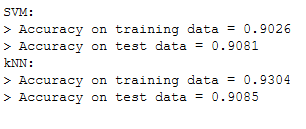1 Introduction
In my previous post I explained the “ensemble modeling method ‘Stacking’”. As it is described there, it is entirely applicable. However, it can be made even easier with the machine learning library scikit learn. I will show you how to do this in the following article.
For this post the dataset Bank Data from the platform “UCI Machine Learning Repository” was used. You can download it from my “GitHub Repository”.
2 Importing the libraries and the data
import numpy as np
import pandas as pd
from sklearn.preprocessing import LabelBinarizer
from sklearn.model_selection import train_test_split
from sklearn.metrics import accuracy_score
from sklearn.model_selection import GridSearchCV
from sklearn.ensemble import StackingClassifier
# Stacking model 1:
## Our base models
from sklearn.neighbors import KNeighborsClassifier
from sklearn.svm import LinearSVC
## Our stacking model
from sklearn.linear_model import LogisticRegression
# Stacking model 2:
## Our base models
from sklearn.neighbors import KNeighborsClassifier
from sklearn.ensemble import RandomForestClassifier
from sklearn.naive_bayes import GaussianNB
## Our stacking model
from sklearn.linear_model import LogisticRegressionbank = pd.read_csv("path/to/file/bank.csv", sep=";")3 Data pre-processing
Since I use the same data approach as with “Stacking”, I will not go into the pre-processing steps individually below. If you want to know what is behind the individual pre-processing steps, read “this” post.
safe_y = bank[['y']]
col_to_exclude = ['y']
bank = bank.drop(col_to_exclude, axis=1)#Just select the categorical variables
cat_col = ['object']
cat_columns = list(bank.select_dtypes(include=cat_col).columns)
cat_data = bank[cat_columns]
cat_vars = cat_data.columns
#Create dummy variables for each cat. variable
for var in cat_vars:
cat_list = pd.get_dummies(bank[var], prefix=var)
bank=bank.join(cat_list)
data_vars=bank.columns.values.tolist()
to_keep=[i for i in data_vars if i not in cat_vars]
#Create final dataframe
bank_final=bank[to_keep]
bank_final.columns.valuesbank = pd.concat([bank_final, safe_y], axis=1)encoder = LabelBinarizer()
encoded_y = encoder.fit_transform(bank.y.values.reshape(-1,1))bank['y_encoded'] = encoded_y
bank['y_encoded'] = bank['y_encoded'].astype('int64')x = bank.drop(['y', 'y_encoded'], axis=1)
y = bank['y_encoded']
trainX, testX, trainY, testY = train_test_split(x, y, test_size = 0.2)4 Stacking with scikit learn
Since we have now prepared the data set accordingly, I will now show you how to use scikit-learn’s StackingClassifier.
4.1 Model 1 incl. GridSearch
The principle is the same as described in “Stacking”. As a base model, we use a linear support vector classifier and the KNN classifier. The final estimator will be a logistic regression.
estimators = [
('svm', LinearSVC(max_iter=1000)),
('knn', KNeighborsClassifier(n_neighbors=4))]clf = StackingClassifier(
estimators=estimators, final_estimator=LogisticRegression())clf.fit(trainX, trainY)clf_preds_train = clf.predict(trainX)
clf_preds_test = clf.predict(testX)print('Stacked Classifier:\n> Accuracy on training data = {:.4f}\n> Accuracy on test data = {:.4f}'.format(
accuracy_score(y_true=trainY, y_pred=clf_preds_train),
accuracy_score(y_true=testY, y_pred=clf_preds_test)
))
In comparison, the accuracy results from the base models when they are not used in combination with each other.
svm = LinearSVC(max_iter=1000)
svm.fit(trainX, trainY)
svm_pred = svm.predict(testX)
knn = KNeighborsClassifier(n_neighbors=4)
knn.fit(trainX, trainY)
knn_pred = knn.predict(testX)
# Comparing accuracy with that of base predictors
print('SVM:\n> Accuracy on training data = {:.4f}\n> Accuracy on test data = {:.4f}'.format(
accuracy_score(y_true=trainY, y_pred=svm.predict(trainX)),
accuracy_score(y_true=testY, y_pred=svm_pred)
))
print('kNN:\n> Accuracy on training data = {:.4f}\n> Accuracy on test data = {:.4f}'.format(
accuracy_score(y_true=trainY, y_pred=knn.predict(trainX)),
accuracy_score(y_true=testY, y_pred=knn_pred)
))
GridSearch
Now let’s try to improve the results with GridSearch: Here is a tip regarding the naming convention. Look how you named the respective estimator for which you want to tune the parameters above under ‘estimators’. Then you name the parameter (as shown in the example below for KNN) as follows: knn__n_neighbors (name underline underline name_of_the_parameter).
params = {'knn__n_neighbors': [3,5,11,19]} grid = GridSearchCV(estimator=clf, param_grid=params, cv=5, scoring='accuracy')
grid.fit(trainX, trainY)grid.best_params_
clf_preds_train = grid.predict(trainX)
clf_preds_test = grid.predict(testX)print('Stacked Classifier with GridSearch:\n> Accuracy on training data = {:.4f}\n> Accuracy on test data = {:.4f}'.format(
accuracy_score(y_true=trainY, y_pred=clf_preds_train),
accuracy_score(y_true=testY, y_pred=clf_preds_test)
))
4.2 Model 2 incl. GridSearch
Let’s see if we can improve the forecast quality again with other base models. Here we’ll use KNN again, Random Forest and Gaussion Classifier:
estimators = [
('knn', KNeighborsClassifier(n_neighbors=5)),
('rfc', RandomForestClassifier()),
('gnb', GaussianNB())]clf = StackingClassifier(
estimators=estimators, final_estimator=LogisticRegression())clf.fit(trainX, trainY)clf_preds_train = clf.predict(trainX)
clf_preds_test = clf.predict(testX)print('Stacked Classifier:\n> Accuracy on training data = {:.4f}\n> Accuracy on test data = {:.4f}'.format(
accuracy_score(y_true=trainY, y_pred=clf_preds_train),
accuracy_score(y_true=testY, y_pred=clf_preds_test)
))
Better than Stacking Model 1 but no better than Stacking Model 1 with GridSearch. So we apply GridSearch again on Stacking Model 2.
GridSearch
Here the topic with the naming convention explained earlier should also become clear.
estimators = [
('knn', KNeighborsClassifier(n_neighbors=5)),
('rfc', RandomForestClassifier()),
('gnb', GaussianNB())]params = {'knn__n_neighbors': [3,5,11,19,25],
'rfc__n_estimators': list(range(10, 100, 10)),
'rfc__max_depth': list(range(3,20)),
'final_estimator__C': [0.1, 10.0]} grid = GridSearchCV(estimator=clf, param_grid=params, cv=5, scoring='accuracy', n_jobs=-1)
grid.fit(trainX, trainY)clf_preds_train = grid.predict(trainX)
clf_preds_test = grid.predict(testX)print('Stacked Classifier with GridSearch:\n> Accuracy on training data = {:.4f}\n> Accuracy on test data = {:.4f}'.format(
accuracy_score(y_true=trainY, y_pred=clf_preds_train),
accuracy_score(y_true=testY, y_pred=clf_preds_test)
))
Yeah !!
print(grid.best_params_) 
5 Conclusion
In addition to the previous post about “Stacking”, I have shown how this ensemble method can be used via scikit learn as well. I also showed how hyperparameter tuning can be used with ensemble methods to create even better predictive values.